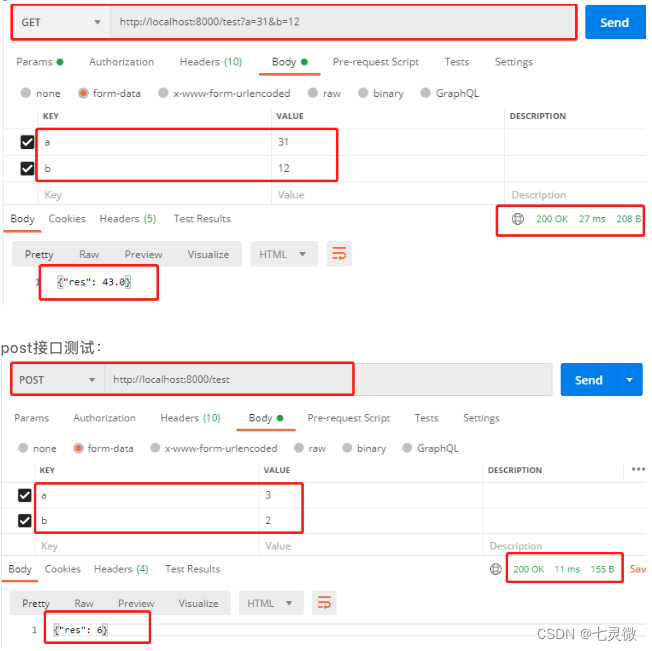最近准备整理一下之前学过的前端+小程序知识笔记,形成合集。顺便准备学一学接口部分,希望自己能成为一个全栈嘿嘿。建议关注收藏,持续更新技术文档。
前端知识技能树
http请求
GET和POST是HTTP请求的两种基本方法,
| GET | POST |
|---|---|
| GET把参数包含在URL中 | POST通过request body传递参数 |
| GET在浏览器回退时是无害的 | POST会再次提交请求 |
| GET请求会被浏览器主动cache | POST不会,除非手动设置 |
| GET产生的URL地址可以被Bookmark | POST不可以 |
| GET请求只能进行url编码 | POST支持多种编码方式 |
| GET比POST更不安全,因为参数直接暴露在URL上,所以不能用来传递敏感信息。 | |
| GET请求参数会被完整保留在浏览器历史记录里 | POST中的参数不会被保留。 |
| GET请求在URL中传送的参数是有长度限制的 | 没有 |
| 对参数的数据类型,GET只接受ASCII字符 | 没有限制 |
| GET产生一个TCP数据;对于GET方式的请求,浏览器会把http header和data一并发送出去,服务器响应200(返回数据); | POST产生两个TCP数据包;对于POST,浏览器先发送header,服务器响应100 continue,浏览器再发送data,服务器响应200 ok(返回数据)。 |
HTTP有GET, POST, PUT, DELETE等等,HTTP的底层是TCP/IP。所以GET和POST的底层也是TCP/IP
(大多数)浏览器通常都会限制url长度在2K个字节,而(大多数)服务器最多处理64K大小的url,超过的部分,恕不处理。
因为POST需要两步,时间上消耗的要多一点,看起来GET比POST更有效。但是:
- GET与POST都有自己的语义,不能随便混用。
- 据研究,在网络环境好的情况下,发一次包的时间和发两次包的时间差别基本可以无视。而在网络环境差的情况下,两次包的TCP在验证数据包完整性上,有非常大的优点。
- 并不是所有浏览器都会在POST中发送两次包,Firefox就只发送一次。
浏览器缓存
后端知识技能树
python_api:flask+flask_restful
在开始之前呢,我们需要安装几个模块,flask+flask_restful
get接口
# coding=utf-8
import sys
import importlib
importlib.reload(sys)
from flask import *
import flask_restful
app = Flask(__name__)
api = flask_restful.Api(app)
class HelloWorld(flask_restful.Resource):
def get(self):
x=request.args['x']#获取参数中的值
y=request.args['y']
return {'hello':y,'donghu':x}#接口返回值
api.add_resource(HelloWorld, '/login',methods=['GET'])#页面路径
if __name__ == '__main__':
app.run(host='0.0.0.0',port=80)#请求地址,以及端口
get接口编写完成,运行,然后在浏览器中输入http://127.0.0.1/login
能正常返回值,那就说明没有问题了。
post接口
# coding=utf-8
import sys
import importlib
importlib.reload(sys)
from flask import *
import flask_restful
app = Flask(__name__)
api = flask_restful.Api(app)
class HelloWorld(flask_restful.Resource):
def post(self):
x = request.form['x']#获取参数
y=request.form['y']
return {'hello':y,'donghu':x}
api.add_resource(HelloWorld, '/login2',methods=['POST'])
if __name__ == '__main__':
app.run(host='0.0.0.0',port=80)
post接口和get接口编写方式上差不多,只是接收参数的方式稍有调整。运行,然后在浏览器中输入,http://127.0.0.1/login2,看是否能正常访问。
python_api:FastAPI+Tornado
python提供了很多web框架,帮助我们快速构建API,如Flask、FastAPI、Tornado。
Flask、FastAPI如出一辙,所以这里只讲FastAPI+Tornado,如何构建GET和POST接口。
pip install fastapi
pip install uvicorn
pip install tornado
# -*- coding: utf-8 -*-
from fastapi import FastAPI
from pydantic import BaseModel
import uvicorn
app = FastAPI()
class Item(BaseModel):
a: int = None
b: int = None
@app.get('/test/a={a}/b={b}')
def calculate(a: int=None, b: int=None):
c = a + b
res = {"res":c}
return res
@app.post('/test')
def calculate(request_data: Item):
a = request_data.a
b = request_data.b
c = a + b
res = {"res":c}
return res
if __name__ == '__main__':
uvicorn.run(app=app,
host="localhost",
port=8000,
workers=1)
将上述代码保存为get.py,存储在某一路径
首先,进入python文件路径,在控制台启动服务
浏览器测试:访问http://localhost:8000/test/a=31/b=12

postman测试:

FastAPI的交互测试:访问http://localhost:8000/docs

Tornado比FastAPI更能承受高并发。
import tornado.httpserver
import tornado.ioloop
import tornado.options
import tornado.web
from tornado import gen
from tornado.concurrent import run_on_executor
from concurrent.futures import ThreadPoolExecutor
import time
from tornado.options import define, options
from tornado.platform.asyncio import to_asyncio_future,AsyncIOMainLoop
from tornado.httpclient import AsyncHTTPClient
import asyncio
define("port", default=8000, help="just run", type=int)
class MainHandler(tornado.web.RequestHandler):
def main(self,a,b):
c = float(a) + float(b)
res = {"res":c}
return res
# get接口
def get(self):
a = self.get_body_argument('a')
b = self.get_body_argument('b')
res = self.main(a,b) # 主程序计算
self.write(json.dumps(res,ensure_ascii=False))
# post接口
def post(self):
a = self.get_body_argument('a')
b = self.get_body_argument('b')
res = int(a) * int(b) #主程序计算
self.write(json.dumps(res,ensure_ascii=False))
if __name__ == "__main__":
#运行程序
application = tornado.web.Application([(r"/test", MainHandler),])
application.listen(8000,'localhost')
tornado.ioloop.IOLoop.instance().start()
























 2683
2683











 被折叠的 条评论
为什么被折叠?
被折叠的 条评论
为什么被折叠?








